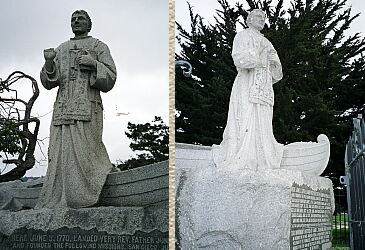 |  |
 |
 |
 |
 |
 |
 Vizcaino Landing Site
Vizcaino Landing Site
 | On December 15, 1602, 60 years after Juan Cabrillo discovered Monterey Bay, Sebastian Vizcaino anchored here. He went ashore the next day and landed on a sandy beach where a small stream emptied into the bay from a ravine. This is the place where Vizcaino planted the Spanish flag and claimed California for Spain.
|
 |  |
Read about the founding of Monterey at the Monterey County Historical Society website.
 |  |
More about the monument at the Partnership website.
Read about the founding of Monterey at the Monterey County Historical Society website.
El Castillo SiteIn 1792, the Spaniards built El Castillo as an outpost of the Monterey Presidio at this hill, overlooking the harbor. Later the Castillo replaced the presidio as the main military post for the Spanish, Mexican and finally US American troops. |  El Castillo in 1855 (c) Olof Dahlstrand |
 |  |
Read more about this incident at Hipolito Bouchard and the Raid of 1818.
 | Prior to giving his first Mass in Alta California, Father Junipero Serra buried the only casualty of the voyage north from San Diego, boat caulker Alexo Nino, a black Freeman. Nino died on board the "San Antonio," anchored in Monterey Bay on June 2, 1770 and became the first the first non-Indian to be buried in CaliforniaNino was a native of Acapulco. That is all we know. We don't know where is ancestors came from and we don't know what he looked like. In all the guidebooks and at all the websites covering Monterey's sights, I couldn't find a single notion of Alexo Nino and his grave - sad prove that American history is still written as white men's history only until this day. |
Now, turn away from the ocean and look up the hill. Move on to the other two sites in the park, the Presidio Museum and the Sloat Monument.Museum Hours:Monday 10:00 a.m. to 1:00 p.m. |

|
 |  |
 | Dedicated in 1910, the monument commemorates the capture of Monterey on July 7th, 1846 by American forces under the command of Commodore John Drake Sloat.
More about the munument at the Partnership website. |
 | Humaya Dancers of the Costanoan-Rumsen Carmel Tribe. |
 |
 |
 |
 |
Starting Page |  | Starting Page |  |
  |   |